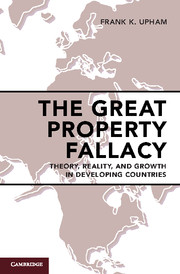Book contents
- Frontmatter
- Dedication
- Contents
- Preface
- Acknowledgments
- 1 Introduction
- 2 Physics Envy: Property Rights in Development Theory
- 3 Property and Markets: England and America
- 4 Property and Politics: Japan
- 5 Law and Development without the Law Part: China
- 6 Theory in Action: Cambodia
- 7 Property Rights and Social Change
- Index
5 - Law and Development without the Law Part: China
Published online by Cambridge University Press: 19 January 2018
- Frontmatter
- Dedication
- Contents
- Preface
- Acknowledgments
- 1 Introduction
- 2 Physics Envy: Property Rights in Development Theory
- 3 Property and Markets: England and America
- 4 Property and Politics: Japan
- 5 Law and Development without the Law Part: China
- 6 Theory in Action: Cambodia
- 7 Property Rights and Social Change
- Index
Summary
We have examined the central impact that formal law can exert in shifting the legal right to valuable resources, whether for purely economic reasons (England, America) or for political as well as economic purposes (Japan). We now turn to the very different case of China, specifically its last four decades of explosive economic growth, an achievement in which law, in both legislative and judicial forms, has played little part.
To understand how China developed so quickly without the presumed basic legal necessities of economic growth, we look at four different areas of economic success: the township and village enterprises or TVEs, which thrived in rural China during the almost total legal vacuum of the 1970s and 1980s; the improvised structures created by foreign direct investors and their Chinese partners to substitute for formal property rights; the sometimes legal, often corrupt, and usually unfair expropriation of farmers' collective land by expanding cities; and the emergence of illegal but vibrant, sustained, and diffuse real-estate markets, known as “small property rights,” in most large Chinese cites. But before we get to the stories of growth in these four sectors, some historical background is necessary.
THE EVOLUTION OF CHINESE PROPERTY LAW SINCE REFORM AND OPENING
Despite the primacy of the industrial proletariat in Marxist theory, the Chinese Communist Party (CCP) came to power in 1949 on the backs of poor tenant farmers and immediately rewarded them with a comprehensive land reform. The new regime's provisional Constitution had declared that the state “must systematically transform the feudal and semi-feudal land ownership system into a system of peasant land ownership,” and a thoroughgoing redistribution of land followed immediately under the Land Reform Act of 1950. By 1953, 40 percent of Chinese land had been redistributed to 60 percent of the population, and almost 300 million farmers had received approximately 700 million mu (1 hectare = 15 mu) of agricultural land.
In 1954, the first Constitution of the PRC ratified the land reform and established four forms of ownership: state, individual worker, capitalist, and collective. The last encompassed rural land and foreshadowed the eventual elimination of individual land ownership. The collectivization process had begun in 1948 with voluntary Mutual Aid Teams, went through various forms of decreasingly voluntary cooperatives, and eventually culminated in 1958 in the transfer of all remaining private rights to local People's Communes of which all farmers became members.
- Type
- Chapter
- Information
- The Great Property FallacyTheory, Reality, and Growth in Developing Countries, pp. 83 - 105Publisher: Cambridge University PressPrint publication year: 2018



